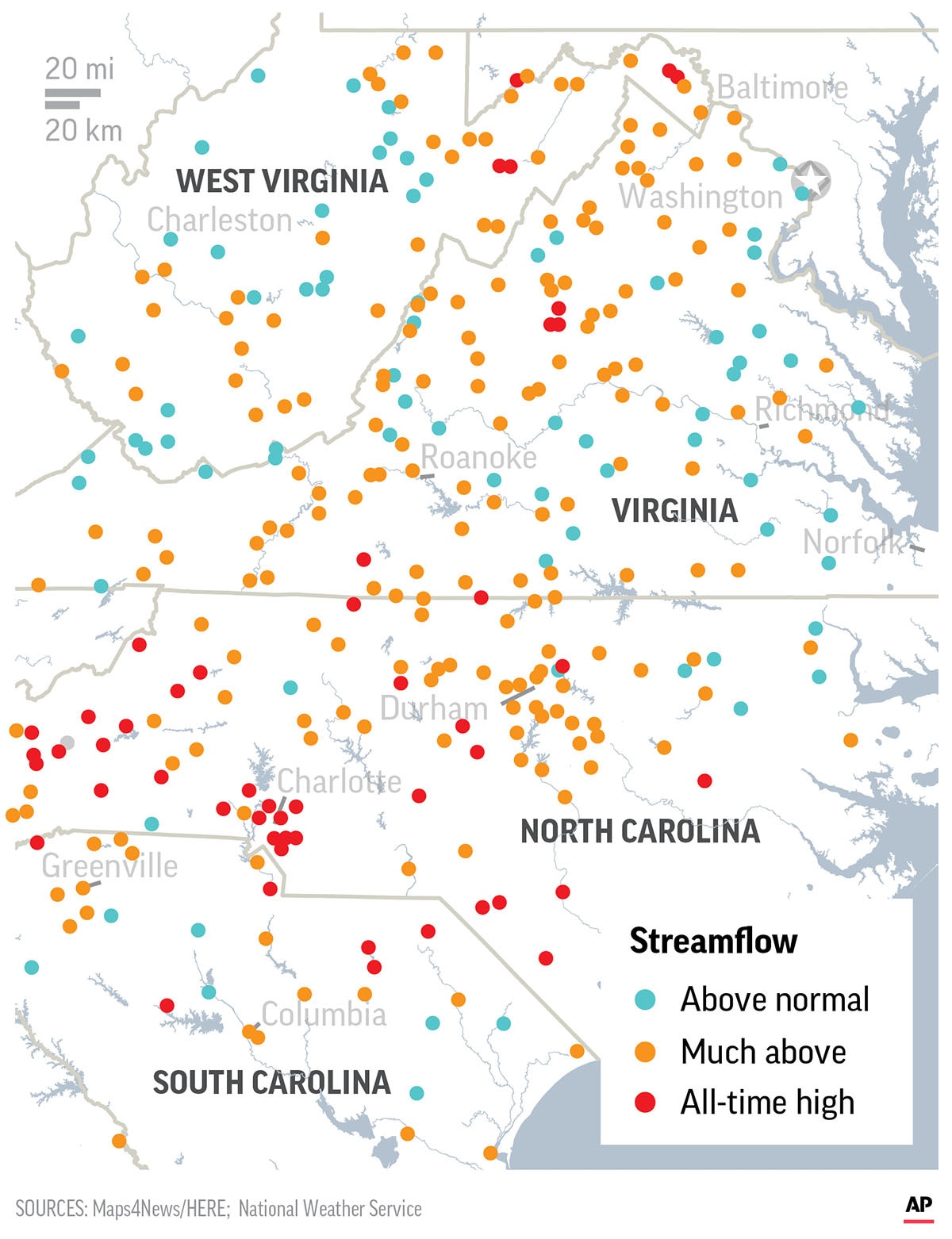Share
WILMINGTON, N.C. — Emergency workers delivered truckloads of food and water to Wilmington, a city of 120,000 people cut off from the rest of North Carolina by Florence’s still-rising floodwaters, as helicopters and boat pulled people from homes swamped by swollen rivers.
Flooding worries were increasing in West Virginia and Virginia, where roads were closed and power outages were on the rise. About 500,000 homes and businesses were in the dark.
The storm’s death toll climbed to 18 as authorities found the body of a 1-year-old boy who was swept away by floodwaters in North Carolina after his mother drove into floodwaters and lost her grip on him while trying to get back to dry land.
The head of the Federal Emergency Management Agency warned that other states, including West Virginia and Ohio, would be affected later in the week.
North Carolina emergency response officials tweeted that 23 truckloads of military meals and bottled water were delivered overnight to Wilmington , the state’s eighth-largest city.

Roads Flooded and Blocked by Fallen Timber
Signs on a flooded highway leading out of town said “ROAD CLOSED,” and many streets that weren’t flooded were blocked by fallen timber. The smell of cracked pine trees wafted through hard-hit neighborhoods.
Residents waited for hours outside stores and restaurants for water and other basic necessities. Police guarded the door of one store, and only 10 people were allowed inside at a time.
Desperate for gas to run a generator at home, Nick Monroe waited in a half-mile-long line at a Speedway station even though the pumps were wrapped in plastic. His power went off Thursday before Florence hit the coast, but he couldn’t recall exactly when.
“It’s all kind of a blur,” Monroe said.
County commission Chairman Woody White said officials were planning for food and water to be flown into the coastal city, located on a peninsula with the rising Cape Fear River to the west and more water to the east.
To the north in Pollocksville, Coast Guard members used a basket suspended from a helicopter to rescue a man from the roof of a flooded home.
About 70 miles away from the coast, residents near the Lumber River stepped from their homes directly into boats floating in their front yards. River forecasts showed that the scene could be repeated in towns as far as 250 miles inland as waters rise for days.
Florence was still massive, despite being downgraded to a tropical depression from a once-fearsome Category 4 hurricane. Radar showed parts of the sprawling storm over six states, with North and South Carolina in the bull’s-eye.
Worst Flooding in the State’s History
In North Carolina, fears of what could be the worst flooding in the state’s history led officials to order tens of thousands to evacuate, though it wasn’t clear how many had fled or even could.
“I have everything I need for my whole family,” Merlos said. Nearby, a Waffle House restaurant limited breakfast customers to one biscuit and one drink, all takeout, with the price of $2 per item.
Julie Lamb, with her 15-month-old twins, stepped off a Coast Guard boat after being rescued from her parents’ house, where the yard was submerged and water was still rising at Lumberton. Another boat was going back to get her husband, 4-year-old daughter and their pug dog.
“We decided to stay with mom and dad here. During (Hurricane) Matthew the water never reached their house,” she said. “But the water keeps coming up in their yard.”
As rivers swelled, state regulators and environmental groups monitored the threat from gigantic hog and poultry farms in low-lying, flood-prone areas.
Posing a Significant Pollution Threat
The industrial-scale farms contain vast pits of animal feces and urine that can pose a significant pollution threat if they are breached or inundated by floodwaters. In past hurricanes, flooding at dozens of farms also left hundreds of thousands of dead hogs, chickens and other decomposing livestock bobbing in floodwaters.
Some stream gauges used to monitor river levels failed when they became submerged, but others showed water levels rising steadily, with forecasts calling for rivers to crest at or near record levels. The Defense Department said about 13,500 military personnel were assigned to help relief efforts.
Thousands of people were ordered to evacuate homes along rivers. The evacuation zone included part of the city of Fayetteville, population 200,000.
Near the flooded-out town of New Bern , where about 455 people had to be rescued from the swirling flood waters, water completely surrounded churches, businesses and homes. In the neighboring town of Trenton, downtown streets were turned to creeks full of brown water.
The rain was unrelenting in Cheraw, a town of about 6,000 people in northeastern South Carolina. Streets were flooded, and Police Chief Keith Thomas warned people not to drive, but the local food and gas store had customers.
“As you can tell, they’re not listening to me,” he said.
Categories

Ruthie Is a Shy Sweetheart Looking for a Second Chance


















